A breath of fresh (1.5 million year old!) air
5 November 2013
If you pour a glass of water from your kitchen tap, you will see lots of bubbles in it. Now, imagine that the entire glass and its contents froze instantly: you would see the ice and all those little air bubbles trapped inside it. If, much later, thousands of years later in fact, a scientist came across this glass with its frozen water and tapped into the bubbles, they would find old air from your kitchen trapped inside! Tapping into air trapped in ice sheets from hundreds of thousands of years ago is one of the key ways that scientists can understand what the Earth’s atmosphere was like back then. By testing this old air they can find out about the amount of greenhouse gases that were in the atmosphere in the past. This can then help them to understand how warm or cold it used to be on Earth – remember that more greenhouse gases make the Earth warmer. (They can also measure the temperature independently of the greenhouse gases, as we explain in the ‘Fun facts’.) By using these past records, we can start to understand how the climate has changed. This can help us see what might happen in the future, as humans add more carbon dioxide – a greenhouse gas – to the atmosphere. Scientists drilling for ice in Antarctica have been able to find ice with bubbles up to 800,000 years old, but now they want to find out what the Earth’s atmosphere was like before then. Swiss-based scientist Hubertus Fischer and other researchers want to find ice that is up to 1.5 million years old, so that they can study really old air to know what the Earth’s climate was like even further in the past. Hubertus has come up with a way to predict where this very old ice might be in Antarctica, and is planning to drill for this ice within the next few years.Find out more
How does air get trapped in ice?
Snow is generally fluffy and easy to pick up with lots of air in between the flakes, but when it has been left for a few days it becomes more solid and icy. This is because the snowflakes settle down on top of each other and compact, melting a little and then refreezing. They all get stuck to each other, but still have air in between them. When more snow falls, it covers the ice so the air gets trapped inside. As more and more snow falls, this air continues to be trapped, and so you can get little snapshots of what the air was like at different times when snow piled up in the past. At the poles, there is lots of snow and very cold conditions: this means that lots of ice forms over thousands of years, so we get very thick sheets of ice with lots of air trapped in it.
How do we test the air?
Scientists drill deep into the polar ice using special equipment (a hollow drill), to get a cylinder of ice, known as an ice core. Imagine putting your finger on top of your drinking straw, then pulling up the straw and seeing it full of your drink – the straw is the hollow drill and your drink is the ice. Once the scientists have the core, they take it back to their super-clean laboratories where they can study the ice without contaminating it with the surrounding air. The researchers then put it into a machine that shakes the ice core really hard (or into a different machine that melts the ice), so that the little ice balls all come apart, letting the air trapped between them escape. This air is then taken away and analysed using other machines that can tell us about the different types of gases that were trapped within the ice.
What gases are measured?
Scientists want to look for what we call greenhouse gases, as well as other gases that might have been present long ago. Greenhouse gases that are in our atmosphere allow heat from sunlight into the atmosphere from space, but then trap some of the heat inside it, warming our planet. Greenhouse gases include carbon dioxide, methane, nitrous oxide and carbon monoxide. As humans produce more carbon dioxide from industrial processes, we are contributing to the heating of the planet, a problem that gives rise to climate change.
How can scientists estimate temperature from ice cores?
Ice and water are made up of hydrogen and oxygen (O). Scientists use the oxygen from ice cores to estimate past temperatures. Oxygen atoms are made up of protons, neutrons and electrons; some oxygen atoms (called 18O) have more neutrons, so they are heavier than other oxygen atoms (called 16O). It takes more energy, or heat, to evaporate water containing the heavier oxygen. So, in periods when the Earth’s air temperature was cooler, the water vapour in the air contained more of the lighter oxygen atoms, and less of the heavy ones.
As this moist air is transported towards the poles and cools down, the water vapour carrying 16O eventually falls as snow to form ice, and this ice is full of the lighter oxygen atoms. On the other hand, ice formed when air temperature was warmer contains more of the heavier oxygen. Therefore, by measuring how much heavy and light oxygen there is in the ice cores, scientists can estimate the Earth’s past temperature!
Print version
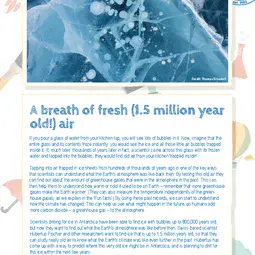
This is a kids' version of the EGU article: 'A breath of fresh (1.5 million year old!) air'. It was written by Jane Robb and reviewed for scientific content by Sam Illingworth and Kathryn Adamson and for educational content by Abigail Morton. We are also grateful to Valérie Masson-Delmotte for her comments.
Translations
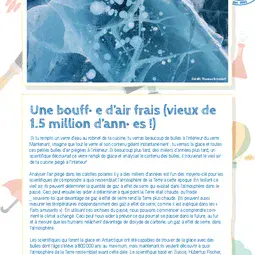
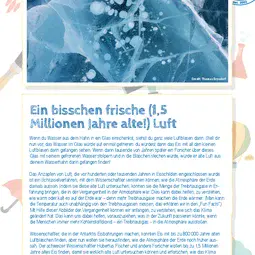
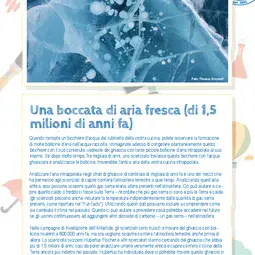
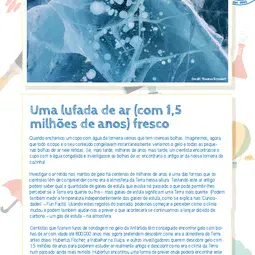
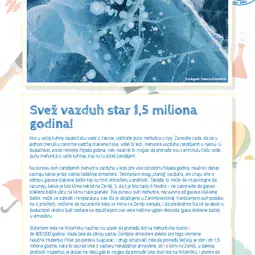
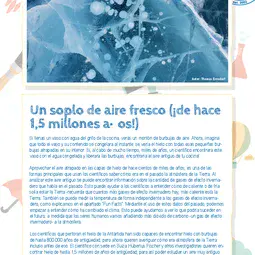
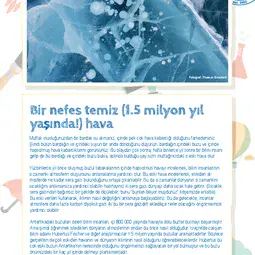
All English-language Planet Press releases are carefully edited, reviewed and proofed, by scientists, educators and EGU staff. Please note that once translated, Planet Press releases receive no further checks from EGU staff. For this reason, we cannot guarantee their accuracy, though we trust the quality of our voluntary translators and are grateful for their work.

